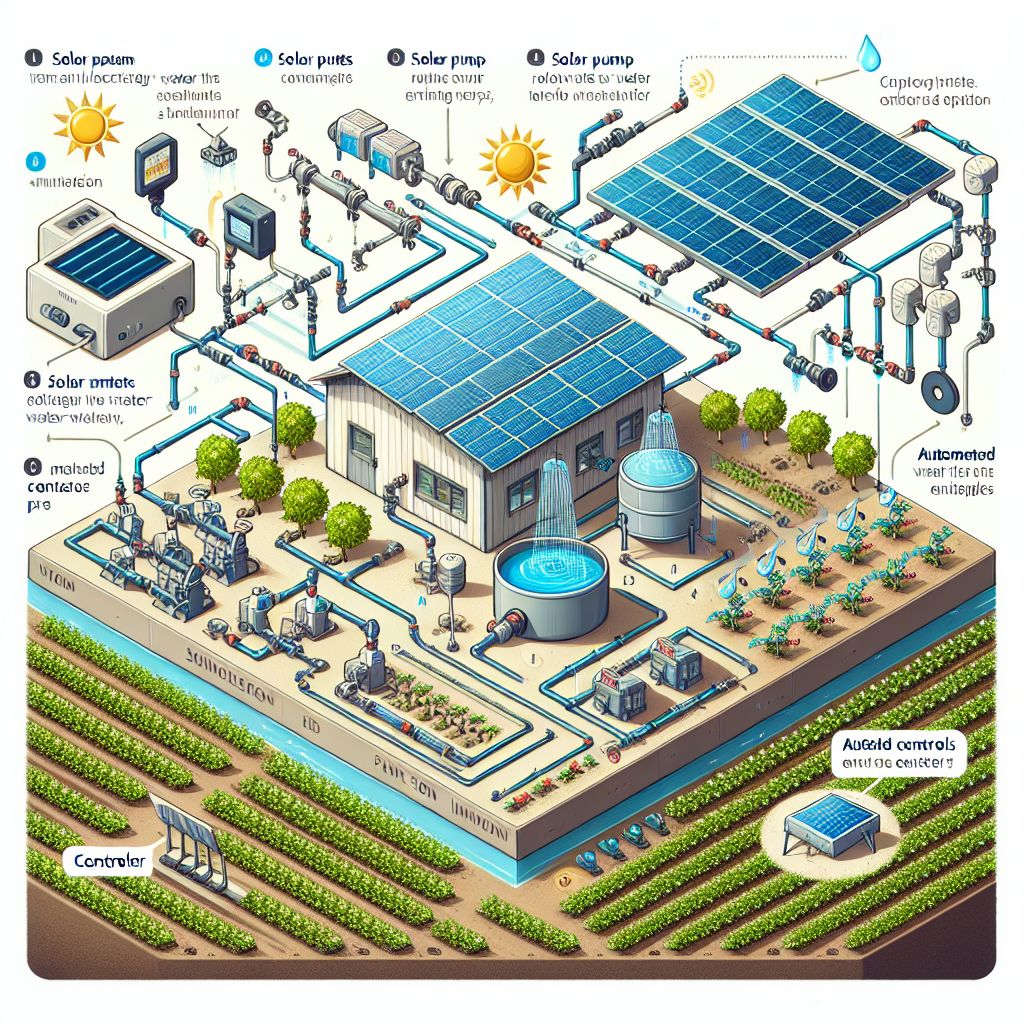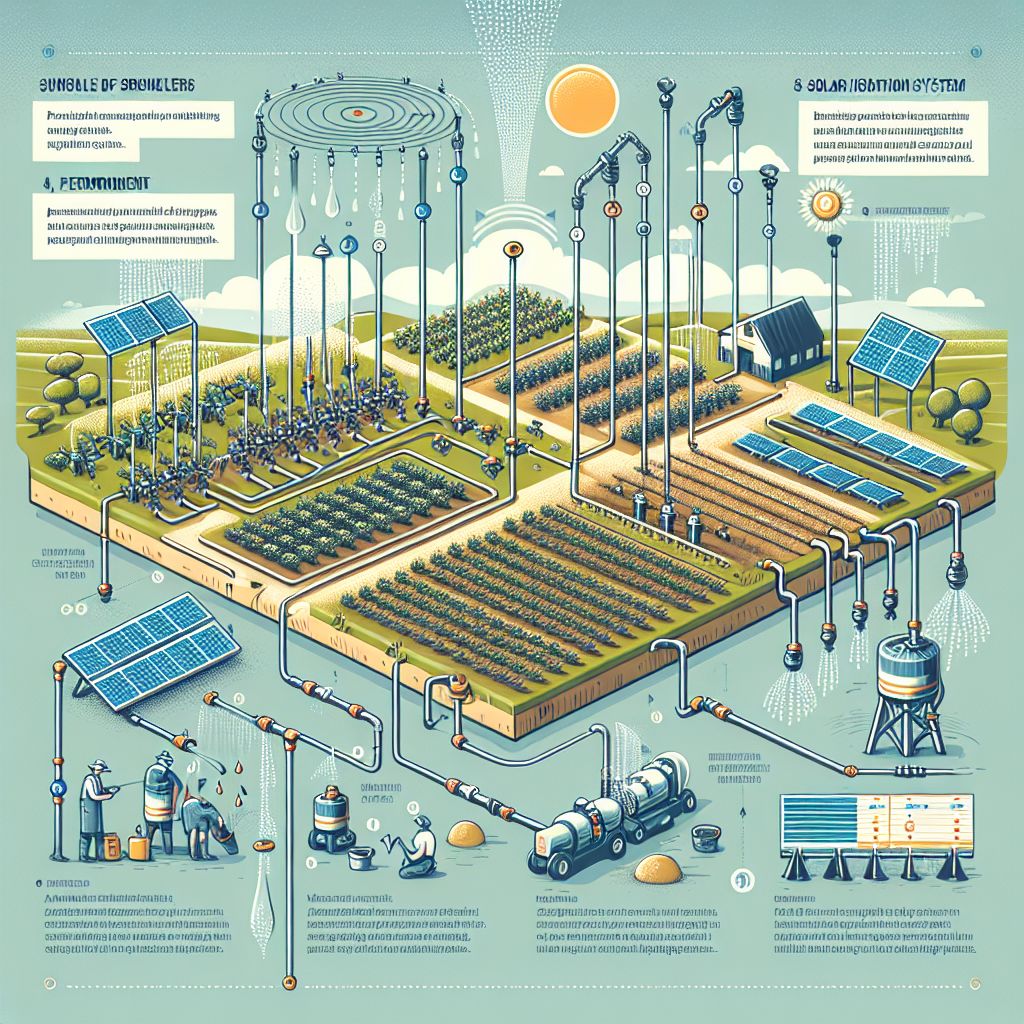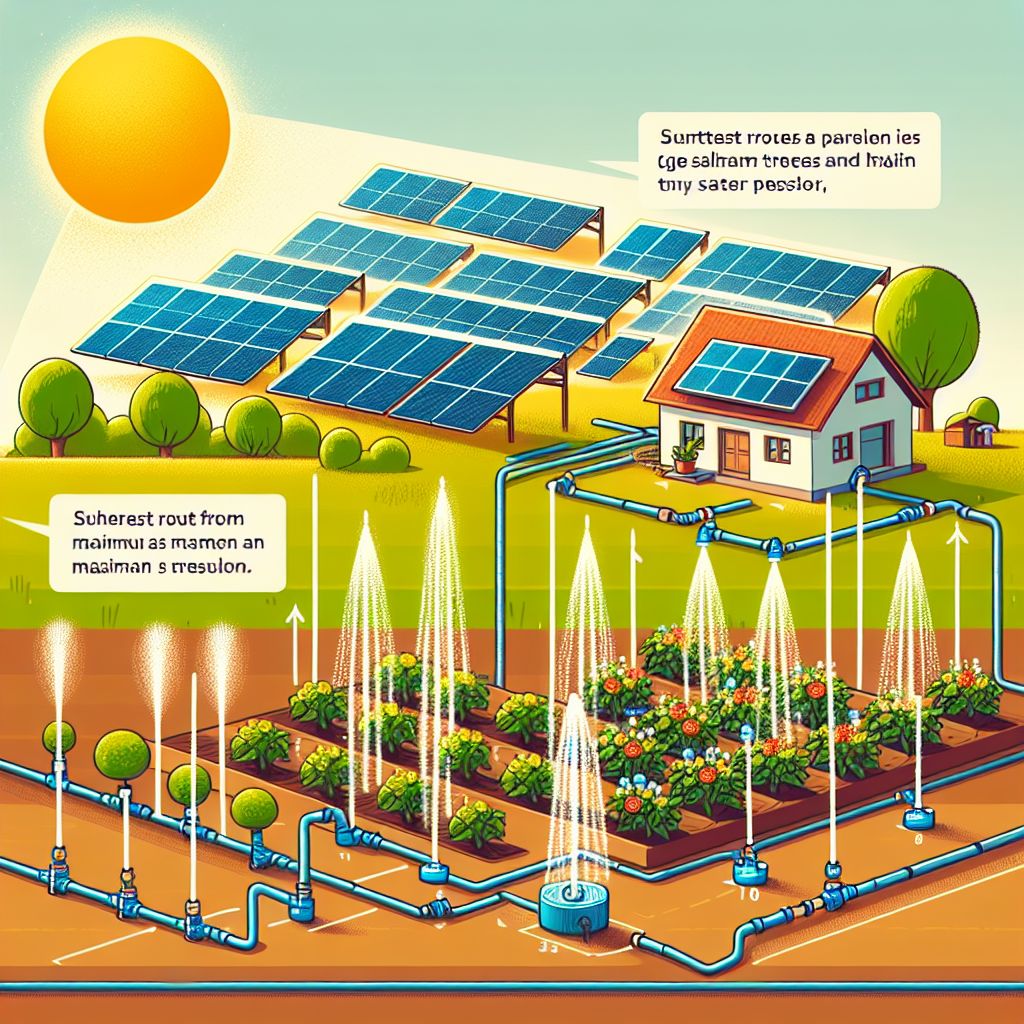
Key Points
Solar irrigation systems use solar energy to power pumps, providing an affordable and environmentally friendly way to irrigate crops.
Knowing your farm’s specific water requirements and sun exposure is essential for designing an effective solar irrigation system.
The main components of a solar irrigation system are solar panels, a pump, controllers, and irrigation infrastructure such as pipes and emitters.
Routine maintenance, such as cleaning solar panels and checking for leaks, is crucial for the system’s lifespan and efficiency.
Financial assistance in the form of grants and subsidies may be available to help cover the initial costs of installing a solar irrigation system.
Harvesting the Sun: Your Solar-Powered Irrigation Guide for a Small Farm
What is a small farm?
When we mention small farms, we’re referring to farms that are usually more personal, where the farmer knows every corner of their land and every plant on it. These farms can be a few acres to a few dozen acres in size, but they all need intelligent, sustainable solutions to grow their crops efficiently.
The Importance of Solar Irrigation for Small Farms
Every resource is crucial for small farms. Water is an invaluable resource, and the way it is managed can mean the difference between a bountiful harvest and a crop failure. This is where solar irrigation comes into play. By harnessing the sun’s free power, you can water your crops without incurring a massive energy bill, thus ensuring the profitability and sustainability of your farm.
First and foremost, solar irrigation systems provide you with the power. You are no longer subject to the whims of unpredictable weather or the high cost of fuel for conventional irrigation pumps. Instead, you can use the reliable energy of the sun to keep your crops hydrated and your soil fertile.

Building Blocks for a Small Farms Solar Irrigation System
Getting to Know the Basics
Before we start with the setup, let’s get to know the different parts of a solar irrigation system:
Solar Panels: These are the power generators that convert sunlight into electricity.
Solar Pump: This device utilizes the electricity generated by your panels to pump water from the source to your crops.
Controllers: These components regulate the flow of electricity and water, ensuring your system operates efficiently.
Irrigation Infrastructure: This includes all the pipes, valves, and emitters that deliver water directly to your plants.
Each component plays a crucial role, and understanding how they work together is the first step in setting up a system that caters to your farm’s unique needs.
Automated Controls and Sensors: The Command Center of Your Solar Irrigation System
Automated controls and sensors are the command center of your solar irrigation system. They keep an eye on things like how wet the soil is and how strong the sunlight is. They use this information to decide when your crops need watering. This saves water and makes sure your plants get what they need, when they need it.
What you need to know about pipes and drips
The efficiency of your solar irrigation system depends on the quality of your pipes and drips. The pipes are responsible for transporting water throughout your farm, while the drips control the amount of water each plant receives. Overwatering can be just as harmful as underwatering, so it’s important to get the balance right. This is why the quality and layout of your pipes and drips are so important.
When designing your irrigation system, think about the shape of your land and the water requirements of your crops. A good system will minimize water waste and maximize the area it covers, ensuring that every drop of water is used effectively.

How to Get Water to Your Crops
Getting water to your crops involves more than just turning on a faucet. It means setting up a system that can distribute water evenly and efficiently across your farm. This system could be as simple as a network of hoses and movable sprinklers, or as complex as a permanent network of underground pipes that feed drip irrigation emitters positioned at each plant.
Choosing the right solar irrigation system for your farm can depend on a number of things, such as the size of your farm, the crops you’re growing, and the condition of your soil. Regardless of the system you decide to use, the objective remains the same: to provide your plants with the water they need to grow in the most effective way possible.
Moreover, you should also think about future growth. As your farm expands, so will your irrigation needs. Designing your system with the possibility of expansion in mind will save you effort and cost in the future.
Below is a table showing irrigation systems that small-scale farmers can choose from.
|
Irrigation System |
Why it’s a Good Option for Small Farms |
|---|---|
|
Watering Can/Bucket |
– Simple and accessible technique that is easy for small-scale farmers to understand and use. 1 |
|
Drip Irrigation |
– Efficient water and nutrient delivery system that can water a wide range of crops. 2, 3 |
|
Sprinkler Irrigation |
– Allows for consistent watering without interrupting seed germination. 2, 3 |
|
Flood/Furrow Irrigation |
– Effective method for controlling water content on farm fields. 2 |
|
Manual Irrigation |
– Requires almost zero economic investment. 2 |
|
Mist Irrigation |
– Suitable for delicate flowers and foliage that need to maintain moisture levels without direct soil contact2 |
Choosing the Right System for Your Small Farm
When it comes to selecting the right irrigation system for your farm, you’ll need to take into account the following factors:
The crops you’re growing and their water needs.
The layout and size of your farm.
Your local weather and the amount of sunlight you get.
Your budget and how much you’re willing to invest upfront.

Step-by-Step Guide: Installing Your Solar Irrigation System on a Small Farm
Now, let’s get your hands dirty and talk about setting up your solar irrigation system. The first thing you’ll need to do is choose the right spot for your solar panels. They should be placed where they’ll get maximum sunlight—usually, this means a south-facing area free from shade.
Choosing the Best Location for Your Solar Panels
It’s important to choose the right spot for your solar panels. You want a location that gets lots of sun all day, every day of the year. Stay away from places that are shaded by trees, buildings, or anything else that could block the sun. The more sun your panels get, the more water you can pump to your crops that need it.
Remember that the angle of your panels can also affect their efficiency. For the most part, you’ll want to tilt them at an angle equal to your latitude to capture the most sunlight over the course of the year.
Setting Up the Pipes and Emitters
Once your solar panels are installed, you can start setting up the pipes and emitters. This is where the design of your farm becomes important. You need to plan the shortest routes from your water source to your crops, avoiding any unnecessary bends that could lower water pressure and efficiency.
There are several types of emitters to choose from, such as drip emitters, micro-sprinklers, and soaker hoses. Drip emitters are an excellent option for getting water right to the base of each plant, reducing evaporation and runoff.

Ensuring Your Solar Irrigation System’s Efficiency on a Small Farm
Like all farming equipment, your solar irrigation system requires regular upkeep to ensure it functions properly. This includes cleaning your solar panels to maximize sunlight absorption, inspecting your pipes for leaks, and confirming that your emitters are free of dirt and debris.
Periodic Cleaning and Checking
Plan a cleaning schedule for your solar panels. Normally, a few times a year should suffice, but this could change depending on your local climate. Additionally, you should regularly check your system for leaks, which can cause water wastage and lower the pressure needed to supply it to your plants.
It’s also important to regularly check your emitters for blockages. If an emitter gets clogged, it can stop water from reaching a plant, which can put the plant in danger. By regularly checking and cleaning your emitters, you can prevent this from happening.
Avoiding and Resolving Typical Problems
Even the most reliable systems can encounter problems. The usual suspects are broken pipes, faulty pumps, and underperforming solar panels. By being on the ball and tackling these issues swiftly, you can stop them from escalating into more serious problems.
For example, if you see a reduction in water pressure, look for leaks or obstructions in your pipes. If your pump isn’t performing properly, it could indicate that your solar panels aren’t producing enough power, possibly because of dirt accumulation or shading.

Calculating the Costs: How Much Does Solar Irrigation Cost?
So, how much will you have to shell out? While setting up a solar irrigation system will require an upfront investment, the potential savings on your water and energy bills over time can be significant. The actual cost will depend on the size and complexity of your system, but here’s a rough estimate:
The below table will discuss the costs of setting up a solar irrigation system for a small farm:
|
Cost Metric |
Details |
|---|---|
|
Upfront System Cost |
– Small, manual solar irrigation systems can cost as little as $502 |
|
Incentives and Rebates |
– Farmers may be eligible for incentives like the USDA REAP grant, which can cover up to 25% of the system cost. 1 |
|
Long-Term Savings |
– Solar irrigation systems have minimal operating costs, as they are powered by free solar energy rather than expensive fossil fuels. 4 |
|
Payback Period |
– With incentives, the payback period for a solar irrigation system can be as little as 8-12 years. 2 |
First-Time Cost and Future Savings for Your Small Farm
The first-time cost of a solar irrigation system can range from a few thousand dollars for a simple setup to tens of thousands for a larger, more advanced system. But keep in mind, this is an investment in the sustainability and efficiency of your farm. Over time, the savings on your energy bills can make up for the first-time cost.
Furthermore, solar panels and pumps usually have a long life, so you’ll be enjoying the rewards for many years. Plus, you’ll be protecting yourself from increasing energy prices and making sure your farm is less affected by droughts and water shortages.
Financial Assistance for Solar Transition: Grants and Subsidies
Remember to research potential grants and subsidies that could aid your transition to solar irrigation. A number of government bodies and organizations provide financial incentives to promote sustainable farming methods, which could greatly lower your initial expenses.
Make sure to investigate local programs in your area. Don’t be afraid to contact agricultural extension offices or sustainable farming groups to help you find and apply for these opportunities.
Shining Success: Practical Examples of Solar Irrigation Triumphs
Case Study: The Effect on Crop Production and Water Conservation
Consider this real-world scenario: a small farm that put a solar irrigation system into action experienced a substantial boost in crop production and a 30% decrease in water usage. The farmer employed drip irrigation powered by solar panels, delivering water directly to the plant roots in a consistent manner. This method of watering not only conserved water but also led to healthier plants and a more plentiful yield.
Interview: A Farmer’s Experience with Solar Irrigation
I recently had the opportunity to talk with Alex, a small-scale vegetable farmer who recently made the switch to solar irrigation. Alex told me, “The upfront cost was a little intimidating, but since making the switch, my water bills have gone way down. And my crops are doing better than ever. It’s made a huge difference in terms of my farm’s sustainability and profitability.”
When questioned about the installation process, Alex responded, “It was unexpectedly simple. I conducted extensive research and collaborated with a local company that focuses on solar configurations for farms. They assisted me in comprehending the unique requirements of my farm and developed a system that was a perfect fit.”
Alex has a piece of advice for other farmers who are considering solar irrigation: “Do your homework, get a good partner, and don’t be afraid to invest in your farm’s future. The benefits far outweigh the costs.”

Smart Watering: Advice for Best Use
Now that your solar irrigation system is operational, let’s ensure you’re maximizing its use. Here are some smart watering tips to maintain your system’s optimal performance:
Timing is Everything: Scheduling Irrigation for Maximum Efficiency
The time of day you water your crops can have a significant impact on their health and growth. The early morning or late afternoon is usually the best time to water because less water evaporates than during the hotter parts of the day. Solar irrigation systems allow you to set timers to water at these times automatically.
Don’t forget that the water requirements of your plants can vary based on the weather and their stage of growth. Monitor your crops and tweak your watering schedule as necessary to make sure they’re receiving the perfect amount of water.
Mixing Old and New: Combining Conventional and Solar Power
For those who are shifting from a conventional system, there’s no need to make the change in one go. You can start by incorporating solar-powered pumps or drip lines into your current system. This will enable you to gradually introduce the new technology while getting a feel for how it interacts with your farm’s unique circumstances.
Once you become more familiar with solar irrigation, you can gradually increase its use on your farm until you eventually transition to a fully solar-powered system that is not only cost-effective but also eco-friendly.
Final Thoughts
In conclusion, solar irrigation systems are a game-changer for small-scale farmers. They provide an eco-friendly solution to irrigation, save on costs in the long run, and give you the reins on your farm’s water management. With proper installation and upkeep, your solar irrigation system could be a key player in your farm’s prosperity for many years.
Commonly Asked Questions
Is It Possible for Solar Irrigation Systems to Work in Overcast Weather?
Yes, it is possible for solar irrigation systems to work in overcast weather. Solar panels can still gather diffused sunlight even when it’s cloudy, although they might not work as efficiently. You might want to think about getting a larger panel array or a battery backup to make sure your irrigation system always has power.
What is the Lifespan of a Solar Irrigation System?
Solar irrigation systems are built to last. Solar panels often have a warranty that lasts 20-25 years, and with the right maintenance, pumps can last for 10 years or more. Regularly cleaning and inspecting your system will help prolong its lifespan even more.
Can I expand my solar irrigation system as my farm grows?
Yes, you can. The great thing about solar irrigation systems is that they are scalable. This means that as your farm grows, you can add more solar panels and pumps or extend your irrigation network to cover more land. It’s a good idea to plan your initial setup with future expansion in mind to make the process easier.
Which Crops Benefit Most from Solar Irrigation?
While solar irrigation is beneficial for most crops, it is particularly advantageous for crops that require precise watering, such as vegetables and fruits. By delivering water directly to the roots of the plants, solar irrigation can improve crop yields and produce quality.
How Can I Keep Track of How Well My Solar Irrigation System is Working?
Keeping an eye on your system is crucial for keeping it running smoothly. Most solar irrigation systems include devices that monitor how much water is being used, how much energy is being consumed, and the overall health of the system. Use this information to make smart choices about when to water and how to maintain your system.







Leave a Reply